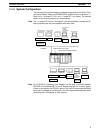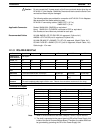
1-2SectionProtocol Overview
5
1-2-1 Host Link Mode
In Host Link Mode, C-mode Host Link commands can be sent from a computer,
PT, or other host to read or write I/O memory in the PC or to control the PC’s oper-
ating modes.
The TXD(––) instruction can be used to send ASCII data to the host. This is
called slave-initiated communications or unsolicited communications.
Note 1. Programming Devices can also be connected in Host Link mode.
2. A 4-wire connection must be used when using an RS-422A/485 port.
Sending C-mode Host Link Commands
Host Link
command
Response
Serial Communications Board
Host computer
Slave-initiated Communications
Serial Communications Board
Host computer
CQM1H
Data
TXD(––)
PC initiates communication.
1-2-2 Protocol Macros
Data transfer procedures (called protocols) with general-purpose external de-
vices can be created as macros using the CX-Protocol to match the communica-
tions specifications of the external device (but, half-duplex communications and
start-stop synchronization must be used).
These protocols are stored in the Serial Communications Boards from the CX-
Protocol, and enable data to be exchanged with general-purpose external de-
vices simply by executing the PMCR(––) instruction in the CPU Unit.
Standard system protocols for exchanging data with OMRON devices (such as
Temperature Controllers, Intelligent Signal Processors, Bar Code Readers, and
Modems) are provided as a standard feature in the Serial Communications
Boards and the CX-Protocol. The CX-Protocol can also be used to change the
standard system protocols according to user requirements.
Serial Communications Board
CQM1H
RS-232C
Message
Protocol made specifically for the
required communications specifications
External device
with RS-232C port
PMCR
(––)
Note There are some restrictions in using the CX-Protocol to manipulate protocols or
perform other operations for the CQM1H-series Serial Communications Board.
These restrictions are described below.


















